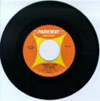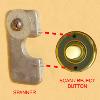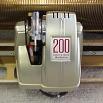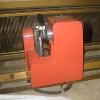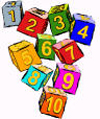Model Name
|
Model #
|
Year
|
Comments
|
Console Unit
|
•C1
•C2
•C3
|
•1952
•195?
•?
|
•sliding glass doors
•flip-down glass doors
•don't think it exists
|
Library Unit
|
•LU-1
•LU-2
•LU-3
|
•1952
•195?
•1957
|
•Service Manual was printed in this year (Most Common Model)
•Never seen it, but if there's an LU3, there should be and LU2
•Service Manual was printed in this year
|
Custom Unit
|
•CU-1
•CU-2
•CU-3
|
•1952
•?
•?
|
•sliding glass doors
•don't think it exists
•don't think it exists
|
Mechanical covers were the same style/color on an LU as on a coin-operated juke for a given
year of manufacture. The only difference being that the LU cover did not incorporate a medallion
on the front. This is because the mechanism in an LU is turned around (180 degrees) and is
hidden inside a wood cabinet, the cover is not in full view like on a coin-operated jukebox. Early
production LU's with the round covers had a Select-o-Matic 200 decal inserted on the cover.
These decals were back-lit on the coin-operated Seeburgs (ie: M100C), but not on the Library
Units. Again, there was no point in back-lighting if it was out of sight. Over the years a lot of
LU's have been cannibalized for their "low mileage" parts and as a result their covers often end
up as replacement covers on their coin-operated cousins. Drill a couple of mounting holes on
the front of an LU cover and you're ready to install a coin-op medallion
Frequently Asked Questions
• See below for more information •
|
...with the seldom found answers
... What model year is my jukebox?
The Seeburg factory used a combination of different mechanical cover styles and colors for
different model years. This chart should help you date your 45 rpm unit. Please keep in mind
that original covers are often replaced or missing.
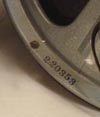
Thanks for the color chart, but my unit is missing the Mech Cover, any other way to date a unit?
If you own a Console (200C-1), you could check the date stamp on the back of Jensen H222
Coaxial Speaker. You will notice several stamps on speaker. The one you need starts with the
numbers "220". The next digit will denote the year of manufacture, and the next two digits will
denote the week of that year. The year of manufacture is confusing because it is only a single
digit, later on Jensen switched to four digits to avoid confusion with decade. Luckily we know that
the H222 speaker was only produced during the decade of the 50's.
Example:
#2205316
220 = manufactured by Jensen
3 = manufactured in 1953
53 = manufactured in the 53rd week of the year noted above.
194_?
195_?
196_?
197_?
Thanks again, but I don't own a Console. Any other way to date a unit?
Take a look at the front of the unit. From what I have been able to gather, units from 1953 and
earlier had three sliding glass doors. Units from 1954 and later had the single flip-down glass
door with lock.
You could also date your jukebox by checking the serial number on the Seeburg ID tag. The only
problem is that I don't have any information on yearly production runs. You could also check the
dates for the patents located on the ID tag (newer models seem to have more patents listed on
the tag).
How much is my jukebox worth?
I can't tell you what it is worth, but I can tell you how much it cost in 1955 and what the equivalent
of that is in 2004 dollars. Take a look at the table below.

I just purchased an LU on ebay. Any suggestions on how to package it so it arrives in one piece?
Here are a few things I would do:
- Remove tubes from the preamp and external amp. Bubble wrap them and put them in a box and
secure the lid.
- Remove the cartridge (w/ needles) from the tone arm. There should only be one screw holding it
in place. Just remove screw, hold tone arm with one hand, and pull on cartridge with other hand
to remove. Bubble-wrap the cartridge and place it in the box with the tubes.
- Remove the Mechanical Cover. Bubble wrap cover and put in a separate cardboard box
(remember that a used Mech Cover in good condition can sell for over $100 alone).
- Tape the fluorescent light tube so that it doesn't jiggle lose during shipping.
- Put tape on both sides of the glass door so that if it does break, the pieces of glass are held
together and don't fall into the unit (tape like the headlights on a 60's road racing car). It is very
common for these units to be missing the glass because they break so easily.
- Make sure the glass door is locked. If you are missing the key (most likely), just wrap the unit a
couple of times with Saran-wrap to keep the door from swinging open. Don't use tape because it
may remove the original lacquer finish or decals off the wood cabinet when you go to peel up the
tape.
- Secure the removable back panel (and top lid on some units) so it doesn't fall off or jiggle during
shipping.
- The chassis sits on springs which in turn sit on two silver-painted wood cleats. The cleats are
fastened to the inside bottom of the cabinet. The springs absorb shock while the jukebox is
scanning/picking up records. When shipped from the factory, the chassis was bolted down to the
silver cleats to prevent it from rattling. There should be a bolt with a nut sticking up from each
wood cleat. Tighten both nuts so the springs compress and the chassis is secured to the cleats.
When you receive the unit, make sure you loosen the nuts (decompress the springs) prior to
playing records.
- Put arrows and labels saying "This End Up" on the boxes. The unit is not designed to be upside
down or on its' side. Without labels, shippers will most likely carry your Library Unit vertically (on
end) on a dolly.
It's a lot of work, but it should help your newly acquired baby arrive in one piece. If you have any other
suggestions, drop me a line and I'll add them to the list.

What is the difference between a 200LU-1 and a 200LU-1P?
According to my "Installation and Maintenance Guide", the suffix denotes the type of
preamp/pickup. There are two variations of preamps that were offered with these units.
"The model 200CU-1 and the Model 200CU-1P are the same except the type of the magnetic
pickup and the input circuit of the preamplifier. A No. 245789 pickup and a Type P A2-L6
preamplifier are associated with the Model 200LU-1. The 200LU-1P has a No. 246796 pickup
and a type PA4-L6 preamplifier."
LAST MINUTE UPDATE: Looks like there are many differences (cabinet size ,wood, finish,
construction, castings, lever panel, and more). Will post this information as soon as it is
compiled by Donnie Duplissey
How do I get a stereo record to play on my mono aural Library Unit?
HELP! Any contributions here would be greatly appreciated - contact me and I'll send you
something in exchange
Can I convert my mono Library Unit to stereo?
Help! Any contributions here would be greatly appreciated - contact me and I'll send you
something in exchange
What is that "thing" mounted on inside of my Library Unit (side frame of my Custom Unit)?
It's located next to the Preamp / Microphone Junction Box / UL labels. There is absolutely no
reference to in any of my manuals or guides. It's actually a special spanner. This wrench is
designed for removing the threaded brass ring (nut) on the "SCAN / REJECT" button located on
the front control panel. You need to remove this ring in order to remove the preamp from the
unit. This tool works way better than the tips of your old needles nose pliers. You won't mar the
soft brass around the pin holes. Why would Seeburg have gone to the trouble of designing,
fabricating and fastening this tool to the side of your jukebox if they didn't feel it was necessary?
Early
Mid
Late
The information below has been provided courtesy of
Jens Hultgren a.k.a. "Dr. Jukebox"
|
Year
|
Coin-op
Jukebox Cover
|
Type
|
Color
|
|
1950
|
M100A
|
Early
|
Beige
|
|
1951
|
M100B
M100BL
|
Early
|
Silver
Green
|
|
Early
|
|
1952
|
M100C
|
Early
|
Blue (turquoise)
|
|
1953
|
HF100G
|
Early
|
White
|
|
1954
|
HF100R
|
Mid
|
Light Blue
|
|
1955
|
V200
HF100J
|
Mid
|
Off-White
Yellow
|
|
Mid
|
|
1956
|
VL200
|
Late
|
Pink Salmon
|
|
1957
|
K
L
|
Late
|
Orange
Green
|
|
Late
|
|
1958
|
101, 161, 201
|
Late
|
Red
|
|
1959
|
220, 222
|
Late
|
Pink
|
|
Seeburg Model
|
Price in 1955
|
2004 Dollar Equivalent
(Adjusted using Consumer Price Index
Equivalence Calculator)
|
Console Unit
|
$895
|
$6,804
|
Library Unit
|
$595
|
$4,185
|
Custom Unit
|
$540
|
$3,798
|
Accessory Amp (HFA1-L6)
|
$88
|
$619
|
I've seen the LU-1 and the LU-3, but what's an LU-2 look like?
I've never seen this elusive beast, if anyone can shed some light please write to me. As far as I
can tell, these are the model numbers Seeburg produced:
Check out "The Seeburg Ed" page of this
site for a few more Frequently Asked
Questions.
|







